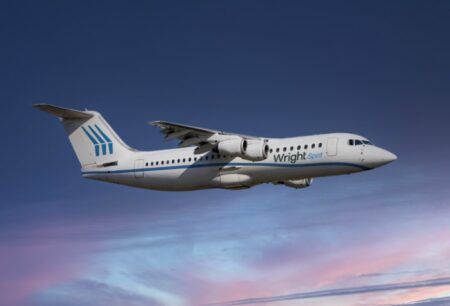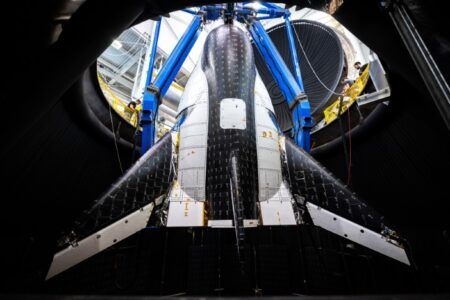Beyond the frozen, fictional realms of Narnia, where one is transported instantly into a winter wonderland simply by stepping through an enchanted [wardrobe] door, there exists an equally magical place back in the real world – the McKinley Climatic Laboratory (MCL) at Eglin Air Force Base, Florida, USA, where the temperature inside can plummet to -65°C while the average local temperature outside during summer is a balmy 25°C.
You could be forgiven for questioning why the US military decided that the Sunshine State was the perfect location to subject all manner of equipment to the worst the weather could possibly throw at it, with a particular emphasis on testing performance at extremely low temperatures.
“The reason the world’s largest climatic chamber is at Eglin AFB is because of the difficulties the military experienced at its previous cold testing facility at Ladd Field in Fairbanks, Alaska, prior to World War II, due to the unpredictability and erratic duration of suitable cold periods,” explains Dwayne Bell, MCL technical chief.
“There was land available here at Eglin, the bombers were stationed here, and so the decision was made to construct a large aircraft hangar that was heavily insulated and could be refrigerated to allow cold weather testing according to the military’s own timeline, instead of having to wait for the right weather up in Alaska.”MCL conducted its first tests in 1947, with a B-29 bomber, C-82 cargo plane, P-80, P-51 and P-47 fighters, as well as an R5D helicopter all undergoing cold weather testing, as well as military trucks, tanks and other equipment. “This is a unique facility,” explains Bell. “It is the only place in the world where you can put a full-scale aircraft inside an enclosed building, operate the engines to full power, and maintain the climatic conditions you wish to test in.”
And the biggest full-scale aircraft to have squeezed inside the MCL’s main hangar to date? “The largest aircraft would be the C-5 Galaxy, which is a US Air Force transport aircraft,” responds Bell. “We haven’t had an actual commercial 747 jet in here as yet, however we did have the Airbus A350 come through the year before last.”
The problem posed by a 747 jetliner is how it would get through the door: “A 747 will physically fit inside the facility,” says Bell, noting that the main chamber is 252ft wide, 260ft deep and 70ft high. “However the 747’s vertical tail is about three or four feet too tall to come under the door header. We had the same issue with the C-5, but that aircraft has the ability to squat in the back to facilitate loading cargo. When in that position, the tail is low enough to come under the door header and the aircraft can be backed into the hangar. We’ve actually proposed to Boeing on numerous occasions that we would notch our door header to accommodate getting the aircraft to come in here, but we’ve never got far enough into discussions for them to commit to that.”
From snow to sun
Since opening, the laboratory has expanded its capabilities to be able to recreate a wide range of climatic conditions from severe Arctic cold to extreme jungle heat and moisture. “This facility was founded to do low- and high-temperature testing,” says Bell. “If you can do that, it doesn’t take long to figure out that you can also do humidity testing. And then if you fabricate some spray nozzle arrays and hang them from the ceiling, you can make it rain inside the building. And if you go and buy some snow-making machines like they use at ski resorts, you can make it snow inside the building. We also have equipment to generate sand storms and dust storms, we have an altitude chamber, and we have a salt fog chamber.”As a result the facility can simulate almost any weather on the planet, with a few exceptions:
“We don’t do lightning strikes here, as there is another Air Force facility that does that up in Ohio [Air Force Research Laboratory, Wright-Patterson Air Force Base],” notes Bell. “We can’t create a tornado either, but we can give you a hurricane if you’re willing to settle for that.”
Asked to put a precise figure on the number and type of aircraft to have been put through their paces at MCL, Bell hesitates. “There is no official count. When I came to work here they were already telling people that they had tested over 300 types of aircraft, with many having been multiple times. That was 25 years ago, so I honestly don’t know what the number is now, but it is many, many hundreds of aircraft.”
As for extremes of temperature, the main chamber at MCL recently ran a sustained test on a high-altitude balloon for Google’s Project Loon that lasted a whole week at -65°C, while temperatures at the other end of the scale can tip 73°C (165°F). The Sun, Wind, Rain and Dust (SWRD) chamber can create wind-blown rain at rates of 25in/hr, while a dedicated altitude chamber can simulate altitude pressures as high as 80,000ft.
Maintaining such extreme conditions in a closed environment for prolonged periods is a full-time, day and night operation. “In the main chamber we are heating and cooling 3,250,000ft3 of air,” explains Bell. “Whether you’re holding that at -65°C or 70°C, you cannot just turn it off at four in the afternoon when you want to go home and turn it back on the next day at seven in the morning. It has to be conditioned all night and over the weekend. We literally test seven days a week.”
Each test program varies in length and focus, with the number and type of test points measured changing from one customer to the next. “There’s no such thing as a typical test,” says Kevin Cogan, a senior test engineer at MCL. “Every one is a little different, it’s set up differently and all the items are usually a little different. I’ve had a customer come in and set up in a day, do one low-temperature day and be gone the next day. Two, three, maybe four days is usually the minimum, but the longest could be anywhere from eight months to a year if it’s a complete aircraft program going through the full spectrum of every single condition.”
Not your average workplace
The facility employs five full-time engineers and 50 support staff, however many more personnel are on-site during a test. “The actual test team provided by the customer can vary from anywhere between two people to over 300, depending on the nature of the test being carried out,” says Cogan. “The folks who work here in the facility all year round don’t actually test the equipment – we just create the simulated weather. When a piece of equipment comes in for test, the customer has to bring their own people to operate it, their own engineers to evaluate the data, and their own maintenance team to fix it if it breaks.”
There is no accommodation on the base itself, but customers can commute in from a range of nearby hotels. A large office space on-site for customer use can accommodate up to 40 people, while each chamber is equipped with an air-conditioned test booth, with telephone lines and internet service. “Customers can work inside the chamber when they’re not testing by communicating with the office and getting their daily operations done,” says Cogan.
However that’s where the ‘ordinary’ ends in this rather extraordinary work environment, where no test is the same and test items are pushed to breaking point, particularly on military programs. “When the military test an aircraft like the F-35, they don’t have to follow FAA guidelines,” notes Bell. “When those aircraft come in here, the teams can operate them at full power, and exercise essentially everything on the aircraft. If you pull the right circuit breakers, the aircraft does not know it’s not really flying through the air.”
Bell is unable to discuss the actual test results from the F-35’s time spent in the main chamber, but he can reveal some of the demanding preparations before its arrival. “From the facility’s perspective, it was the largest test that has ever been accomplished here,” he says. To accommodate the swiveling engine nozzle and lift-fan system of the Lightning II, a 12ft-high ‘restraint and support’ structure interwoven with a system of ventilation ducts had to be designed by Bell and his team to secure the F-35 and allow it to operate at high power in both conventional and short take-off/vertical landing (STOVL) mode while inside the building. A sprinkler system was integrated into the exhaust ducting to absorb some of the sound wave vibrations emitted from the engine, which can produce 40,000 lb of thrust, helping to decrease decibel levels in the chamber during testing.
“With the aircraft that far up in the air, we also needed to build a 4,000ft2 platform around it so that the military maintainers and pilots could access the aircraft as if it were sitting on the ground,” adds Bell. “We also had to build two double garages under the platform to accommodate all their ground support equipment for the testing. It took nine to 10 months working full time to design and fabricate all that hardware, while also supporting the 40 or so other test programs running during the same period.”
A lot of hot air
Ventilation of the exhaust is vital to maintaining a stable temperature inside the chamber. Conditioned air is constantly pumped in to ensure the pressure in the building is always higher than that inside the ducts surrounding the engines of the aircraft being tested and other openings on the aircraft. This difference in pressure ensures the jet exhaust flowing out of the chamber through the ducts is maintained, allowing the facility to remain at a consistent temperature. However, the bigger and more powerful the engine, the more problematic it can become.
“We’re able to run jet engines inside the facility but there is a certain threshold we can’t go beyond,” cautions Bell. “We have two air make-up systems that take outside air, condition it and put it into the chamber to compensate for air that is being sucked out of the chamber by the jet engine and throw it down an exhaust duct to the outside world. As a result, you can’t run really big engines like you get on the A350 up to full power in here. We can only put a maximum 1,000 lb mass of air per second at -65°F into the chamber for approximately one hour as those engines are exhausting out, otherwise we’ll go into a negative and suck the walls in. If the engine is running at less than 1,000 lb/s, or the air is not as cold in the chamber, we can last for many hours.”
Modern, large turbofan engines present a particular problem: “In a high bypass ratio engine, there is a core flow that has products of combustion in it, but there is also a large fan around the perimeter that has no products of combustion in it,” explains Bell. “We are only going to put an exhaust suck that collects and reroutes the core flow from the center of the engine. If you bring an aircraft in here that’s got a 10ft-diameter engine on it, we can get all the core flow exhaust out and keep up with it for air make up, but there’s going to be a limit to how high you can power up the engine, as the winds it would create inside the closed building would be dangerous for the personnel conducting the test.”
Despite the risks of the work carried out at the laboratory, Bell cannot recall a major incident in his time working there. “To my knowledge there’s never been a fatality,” he says. “There are always some minor accidents – people bump their heads, catch their fingers in a door – but we’ve never had any fatalities that I’m aware of. There’s not a single person who walks into that chamber without having had a safety briefing. We also have technicians that are assigned to be in the chamber any time our customers are out there to keep an eye on them. If they believe somebody is suffering from a medical condition relating to the extreme cold or heat, they are fully authorized to get that person out of the chamber whether they want to come out or not.”
And although it is always challenging, Bell continues to revel in his role managing one of the world’s most fascinating testing facilities. “One of the biggest thrills of the job is that the things that come here to be tested are nearly always the latest and greatest technology,” he says. “Take the F-35. It was humbling to stand 100ft from the full afterburn with 70ft of flame out the back of the aircraft, just feeling the pure power of the engine. That’s pretty exciting.” \
Anthony Janes is editorial director at UKIP Media & Events Ltd, publisher of Aerospace Testing International




